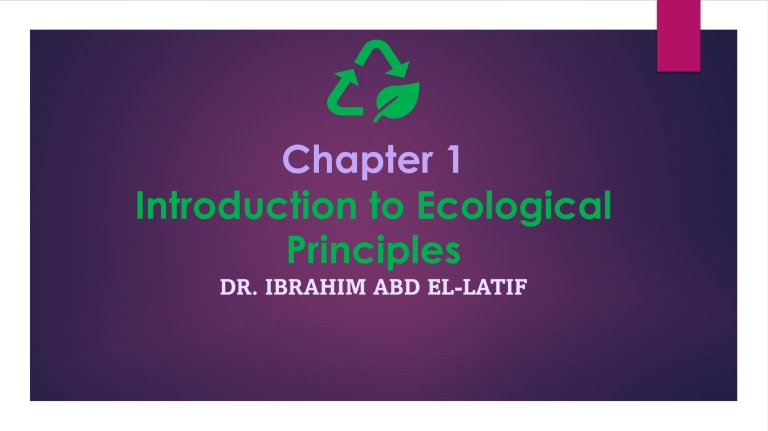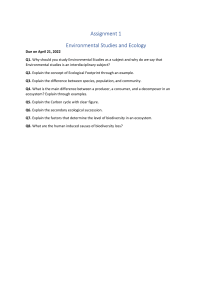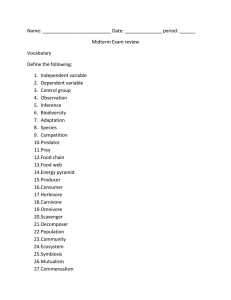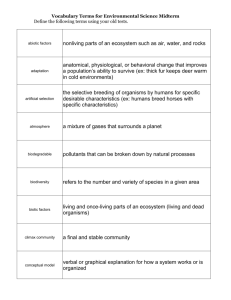
Chapter 1 Introduction to Ecological Principles DR. IBRAHIM ABD EL-LATIF .❑ شرح المجتمع الحيوي والتعاقب البيئي .❑ معرفة المناطق األحيائية الرئيسية في العالم واألنواع السائدة ❑ مناقشة العوامل التي تؤثر على توزيع الكائنات الحية Biotic Community .A Ecological Dominance .B Biomes .C Introduction Ecological Succession .D Concepts of Range and Limits .E Habitat and Ecologic Niche .F A biological community consists of several populations each containing all the members of a single species in each area. They evolve and adapt in response to the environment in which they live. Definitions a.Biomes: المناطق االحيائيه Regions characterized by a similar climate, soil, plants, and animals regardless of where it occurs on earth. b. Ecosphere: المحيط البيئي The interrelation among and between all the earth's living organisms and the atmosphere, lithosphere, and hydrosphere that they occupy. c. Limiting factor: العوامل المحدده An environmental factor that restricts the growth, distribution, or abundance of a particular population. d. Tolerance: التحمل Decreased response to a specific factor in the environment over time. e. Niche: The organism’s adaptation to which it is fitted in its community. A. Biotic Community Biotic community: A natural grouping of different kinds of plants and animals within any given habitat . a Biotic community like ecosystem is a broad term, which can be used to describe natural groupings of widely different sizes, from the various microscopic diatoms طحالب بحريهto the hundreds of species of trees, insects, birds, mammals etc. Population : Individuals of the same species living together within a given area. A population within a biotic community in certain region is not a static entity كيان ثابتbut it is continuously changing in size and reshuffling in hereditary characteristics خصائص وراثيهin response to environmental changes and to fluctuations in the population of other members of the community. B. Ecological Dominance الهيمنة البيئية Ecological Dominants : Organisms exert a major role in controlling influence on the community التأثير على المجتمع. It has dominant role because they not only provide food for other organisms but also directly affect and modify their physical environment, as: 1. They build up topsoil 2. Moderate fluctuation of temperature 3. Improve moisture retention 4. Affect the pH of the soil. Most ecological communities are defined by their dominant species. • In many examples of wet woodland in western Europe, the dominant tree is alder • In temperate bogs, المستنقعات المعتدلهthe dominant vegetation is usually species of Sphagnum طحالب • Some sea floor communities are dominated by brittle stars. • Exposed rocky shorelines are dominated by sessile organisms such as limpets. C. Biomes The species composition of any biotic community is affected by the physical characteristics of the environment particularly temperature and rainfall. An ecosystem can be as small as an oasis in a desert, or as big as an ocean, spanning thousands of miles. There are two types of ecosystems: • Terrestrial Ecosystem • Aquatic Ecosystem i. Terrestrial Ecosystem 1. Forest Ecosystem ( Forests help in maintaining the temperature of the earth and are the major carbon sink) 2. Grassland Ecosystem (the vegetation is dominated by grasses and herbs. Temperate grasslands and tropical or savanna grasslands are examples of grassland ecosystems ) 3. Tundra Ecosystem (found in cold climates or where rainfall is scarce. These are covered with snow for most of the year. Tundra type of ecosystem is found in the Arctic or mountain tops ) 4. Desert Ecosystem (regions with little rainfall and scarce vegetation. The days are hot, and the nights are cold ) ii. Aquatic - Ecosystem Freshwater Ecosystem The freshwater ecosystem is an aquatic ecosystem that includes lakes, ponds, rivers, streams, and wetlands. - Marine Ecosystem The marine ecosystem includes seas and oceans. D. Ecological Succession التعاقب بيئي Ecological succession : The process which organisms occupy a site and gradually change environmental conditions so that other species can replace the original inhabitants السكان األصليين. - Primary succession occurs when a community begins to develop on a site previously unoccupied by living organisms, such as on island, a sand or silt bed ترسبات من الطمي, a new volcanic flow. - Secondary succession occurs when an existing community is disrupted تعطلتand a new one develops at the site. The disruption may be caused by some natural catastrophe كارثة طبيعية, such as fire or flooding فيضانor by a human activity, such as deforestation إزالة الغابات, mining التعدين. Climax community مجتمع الذروة المناخي: An ecological community in which populations of plants or animals remain stable and exist in balance with each other and their environment. A climax community is the final stage of succession, remaining unchanged until destroyed by an event such as fire or human interference - Types of Ecological Succession: Features Primary Succession Secondary Succession Previous Colonization No prior colonization Prior colonization Soil Presence Soil not initially present Soil already present Time Taken Takes more time (about 1000 years or more) Takes less time (50 to 200 years) Progression Speed Slow progression Fast progression Serial Stages Involves many serial stages Involves fewer serial stages Presence previous succession absent previous succession present Examples Bare rock, Newly formed ponds, Newly cooled lava, etc. Deforested land due to forest fires, etc. E. Concepts of Range and Limits مفاهيم المدى والحدود Most species of organisms are not even found in all the region of the world where they could survive. The existence of barriers prevents their dispersal.يمنع انتشارها Law of the Minimum (Liebig's Law) قانون الحد األدنى Each species requires certain materials for growth and reproduction and can be restricted if the environment does not provide a certain minimum amount of each one of these materials. This phenomenon is law of the minimum, which states, "the rate of growth of each organism is limited by whatever essential nutrient is present in a minimal amount". Example: The yield of crops is often limited not by a nutrient required in large amounts, such as water or carbon dioxide, but by something needed only in little amounts, such as manganese. Law of Tolerance (Shelford's Law) قانون التحمل This leads to a concept of range of tolerance, which states, " the distribution of each species is determined by its range of tolerance to variation in each environmental factor."يتم تحديد توزيع كل نوع من خالل نطاق تحمله للتغير متأثرا بكل عامل بيئي F. Habitat and Ecologic Niche ❖ The Habitat of an organism is: the place where it lives, a physical area, and some specific part of the earth's surface, air, soil, or water. However, it is always tangible, More than one animal or plant may live in a particular habitat. ❖ Ecologic Niche Ecologic niche : Every organism have its own role within the structure and function of a community. As it depends on the organism’s structural adaptations, physiologic response, and behavior. ❑ To describe an organism's ecologic niche, we must know what it eats, what eats it, what organism competes with, and how it interacts with and is influenced by abiotic component of the environment (like light, temperature, and moisture). ❑ ❖ It is helpful to think of the habitat as an organism's address (where it lives) and of the ecologic niche as its profession ( مهنةwhat it does biologically). Review Questions 1. What is biotic community? 2. What are the major biomes of our planet? 3. Describe the different kinds of ecological successions. 4. What do we mean by climax community? 5. Explain the difference between habitat and ecologic niche of organisms. 6. Define the law of the minimum ? 7. Define the law of tolerance ?






